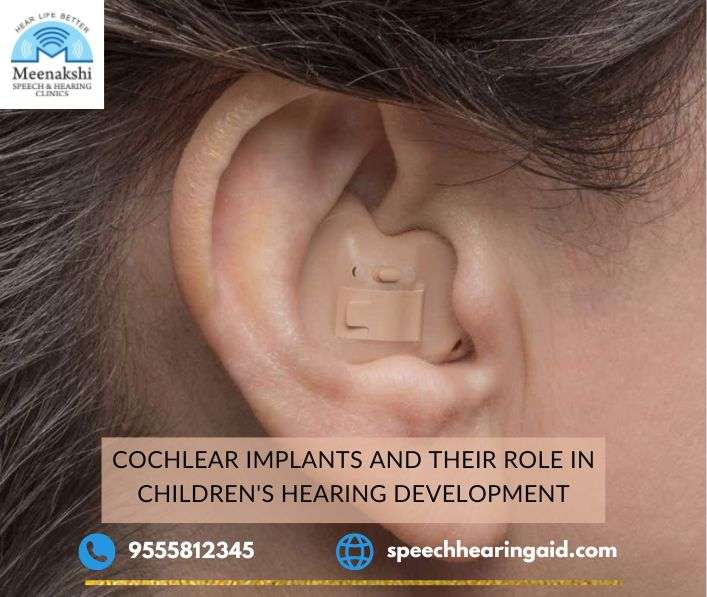Cochlear implants are a type of hearing aid that can be surgically implanted into the ear. In this blog we will explain Cochlear Implant and Their Role in Children’s Hearing Development. Cochlear Implants are designed to help those with severe hearing loss or deafness to hear again. While cochlear implants are not a new technology, their use has been growing in recent years. In 2012, the Food and Drug Administration (FDA) approved the use of cochlear implants in children as young as 12 months old. As of 2018, it is estimated that there are approximately 38,000 children in the United States with cochlear implants. Cochlear implants can offer a great benefit to children with hearing loss. However, there is still much unknown about their long-term effects. In this blog post, we will explore what we do know about cochlear implants and their role in children’s hearing development.
What are Cochlear Implants?
A cochlear implant is a surgically implanted electronic device that provides a person with moderate to profound hearing loss a sense of sound. The implants are most often used in children, as they are the best candidates for developing speech and language skills.
Also see:- Degree of hearing loss
The implant has two main parts: an external receiver-stimulator that sits behind the ear and an internal electrode array that is inserted into the cochlear, or inner ear. The receiver-stimulator picks up sounds from the environment and converts them into electrical impulses. These impulses are then sent to the electrode array, which stimulates the auditory nerve and sends signals to the brain.
Cochlear implants bypass damaged hair cells in the inner ear and directly stimulate the auditory nerve, providing a sense of sound to people who would otherwise be deaf or hard of hearing. In order for someone to qualify for a cochlear implant, they must have damage to their inner ear (cochlea) and not be helped by hearing aids.
Most children who receive cochlear implants are born with hearing loss or develop it early in life. Surgery to insert the implant usually occurs around age 4 or 5, after which time the child will undergo extensive rehabilitation and therapy to learn how to use their new sense of sound. In some cases, children as young as 1 year old may qualify for an implant.
Cochlear implants can greatly improve quality of life for both children and adults with hearing loss. They can provide
How do Cochlear Implants Work?
Cochlear implants are small, complex electronic devices that are surgically placed under the skin of the ear. The devices consists of an internal receiver-stimulator and an external speech processor. The receiver-stimulator is connected to electrodes in the cochlea (the spiral shaped structure in the inner ear that helps transmit sound vibrations to the brain).
The speech processor picks up sounds from the environment, which are turned into electrical signals and sent to the receiver-stimulator. The electrical signals stimulate the auditory nerve, which carries information about sounds to the brain. The brain then learns to interpret these signals as meaningful sound.
Also see:- Hybrid cochlear implants
Cochlear implants do not restore normal hearing but they can provide a useful representation of sound for people who are deaf or hard of hearing. In order for people to benefit from a cochlear implant, they need to have some residual hearing and be motivated to learn how to use it.
The Pros and Cons of Cochlear Implants
There are a lot of things to consider when it comes to cochlear implants. On one hand, they can provide a child with hearing ability that they would not have otherwise. On the other hand, there are potential risks and side effects associated with the surgery and implantation process. Here are some pros and cons to help you make an informed decision about whether or not a cochlear implant is right for your child.
Pros:
1. Cochlear implants can restore hearing in children who are deaf or hard of hearing.
2. Cochlear implants can improve communication skills and quality of life for children who receive them.
3. Cochlear implants do not require ongoing maintenance or care, once they are implanted.
Cons:
1. There is always a risk of complications during surgery to implant a cochlear implant. These complications could include infection, bleeding, or damage to the nerves in the ear.
2. It is possible for the body to reject a cochlear implant, which would require additional surgeries to correct.
3. There is a small risk of developing meningitis after receiving a cochlear implant. Meningitis is an infection of the lining around the brain and spinal cord that can be life-threatening if not treated promptly and correctly
Also see:- Hearing testing
How Cochlear Implants Affect Children’s Hearing Development
Cochlear implants are devices that are surgically implanted into the cochlea, or inner ear. They provide a sense of sound to children who are deaf or hard-of-hearing. Cochlear implants bypass damaged hair cells in the cochlea and directly stimulate the auditory nerve. This direct stimulation allows children with cochlear implants to hear sounds that they would not be able to hear otherwise.
While cochlear implants can offer many benefits to children with hearing loss, it is important to understand how they may affect a child’s hearing development. One concern is that cochlear implants may interfere with the development of residual hearing in children who have some residual hearing before implantation. Another concern is that cochlear implants may delay the development of spoken language skills in young children.
It is important to consult with a speech-language pathologist and Audiologist to determine if a child is a good candidate for a cochlear implants. Once implanted, regular monitoring by these professionals is essential to ensure that the child’s hearing development is on track.
Check out the latest update on Instagram.

